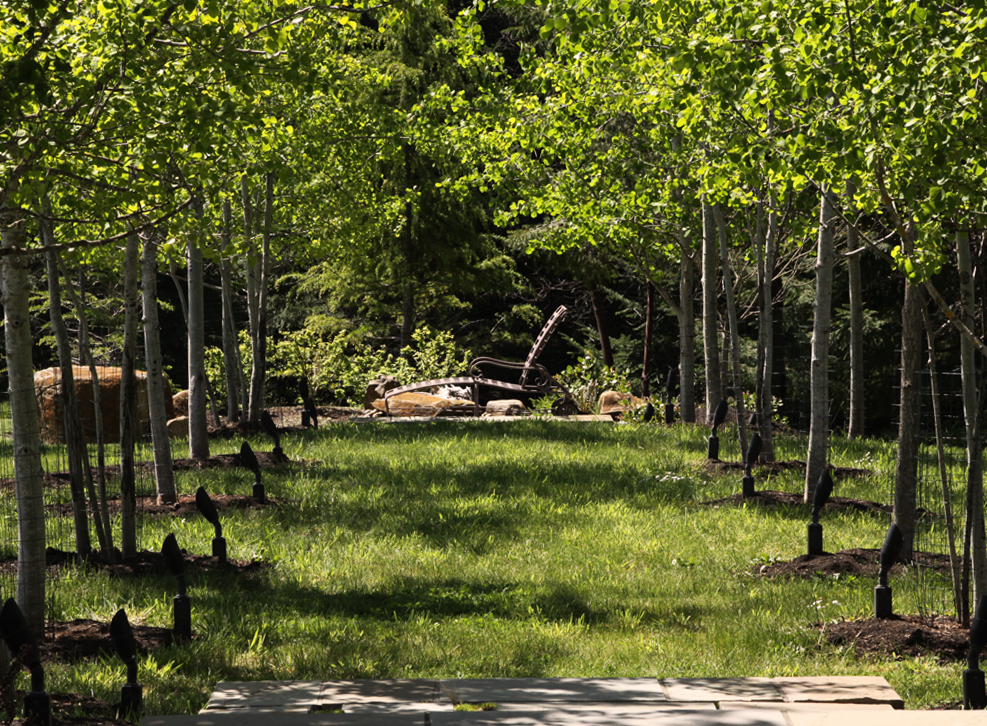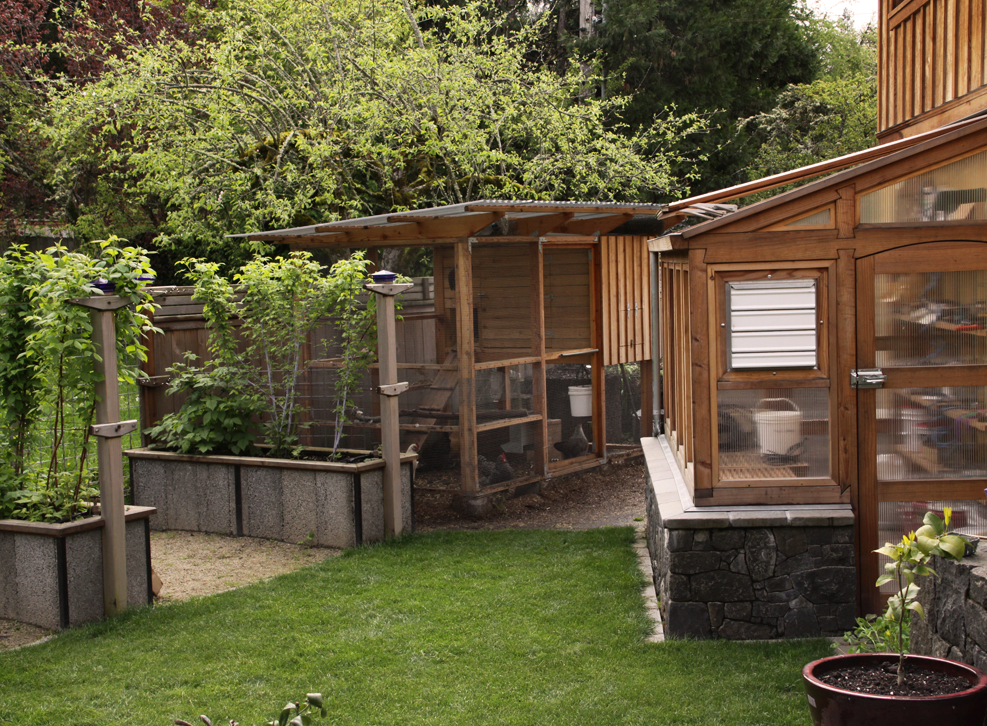To successfully create a feeling of cohesion between the architecture of our homes and our landscapes, the transition between these two living spaces requires delicate management. Whether a site is located in a semi-urban area like Eugene, Oregon, or in a more remote and rural setting, the success of a project hangs on the designers’ ability to elegantly resolve this critical transition. Landscape architects think of the transition as a gradient. The gradient is variable in thickness, transitioning from the built to the natural environment, with any number of bridging values in between. The thickness of the gradient will change depending on several factors such as the landscape context, architectural style, and the client’s desires.
The transition between home and nature may dissolve slowly over a large distance. In these cases, it may be difficult to discern where home meets garden and garden meets landscape. Common materials from the interior architecture may extend into the adjacent garden spaces, and natural stone and planting may find its way into the interior. Then, natural materials may become more dominant as the distance from the home increases. Form, like materiality, also transforms in relation to the gradient of transition. Ninety-degree angles could incrementally disintegrate until geometry melts into organic form.
On the other hand, the transition may be condensed and unfold quite quickly. If the garden itself is architectural in nature, there may not be as many incremental values of change. Consider a courtyard garden, bounded on all sides by architectural form. What is the experience of moving across the interface between interior space and garden in this context? What about the interface between an alpine home and the surrounding wilderness? Maybe in this case, the transition may only call for a careful editing of the surrounding forest. With these examples we can begin to understand how many conditions interact to shape each site’s unique transition.
The most significant intervention along the transition is exactly where and how architecture meets garden. What is the quality of that threshold? Is it marked by a physical transition from one ground plane material to another? Where does the boundary really want to be? The boundary doesn’t necessarily need to create a uniform circumference around the house. In some areas, the surrounding untamed landscape may want to come right up to the house while in other zones, the threshold moves farther afield. The resulting, undulating pattern of transition weaves context, garden, and architecture together.
What is most important is that this choreography of transition feels right and unique to each site. It is our job as landscape architects to help our clients discover an interface that is right for them and their personal architecture and garden.

Landscape architects manipulate space by carefully considering the resulting effects. We very purposefully cultivate opportunities to see a landscape with fresh eyes. At Lovinger Robertson in Eugene, Oregon, we form close working relationships with our clients in order to understand the way they want to interact with their landscapes. This understanding serves as our primary guide during the process of master planning – which in essence is an orchestration of landscape spaces that unfold in a deliberate sequence.
There are places on your property that are special. Places that you want show off to your friends. It may be a walk to get there. But we don’t want to race ahead and skip right to the big reveal. That would be a pretty boring, one note garden performance. Even a tiny courtyard garden can harbor sweet surprises and seasonal change. Why not build a whole symphony of experiences that allows your garden to show off its entire range of potential?
We move through gardens. This means that we can take advantage of the ways in which we tend to physically interact with the space around us. Wide, straight, smoothly paved pathways bounded by vegetation encourage us to move quickly through a space, rapidly getting us from here to there. Winding stone paths encourage us to slow down and enjoy the special planting jewels at our feet. Large terraces with generous seating encourage social gathering. Shady nooks invite personal retreats or close conversations.
What is the character of the journey through these spaces? What do we see as we move through the landscape – not just in our immediate space but also spaces across a distance? Do we see a long view down an allée? Are we looking across a meadow and admiring the interplay of light and shadow? Do we spy a folly on the other edge of a pond? Or maybe a cleverly placed mirror in an intimately sized space reflects a gorgeous section of our garden that is outside our cone of vision.
We can admire at a distance or be seduced to get closer through invitations to explore. A simple bridge spanning the most modest distance begs to be crossed. Giving small previews of places to be discovered whets the appetite for more. We may be walking along when we catch a glimpse through an opening in the trees or a window in a wall of something beautiful – light glinting on water’s surface, a cacophony of flowers in bloom, or a sweeping view across a valley. We remember that moment in the back of our minds as we move through different spaces. Suddenly, we round a corner and – ah! There it is!
The process of getting to the special places in our garden prepares us to stretch our enjoyment to maximum heights. The choreographed journey allows us to incrementally shed our worries, stress, and cares so that we can find peace and appreciation in our gardens over and over again.

What is truly special about growing food in our gardens? Living in Eugene, Oregon, we can easily find locally grown, delicious produce from farmers markets or CSA’s. Perhaps we feel the magic of food harvested from our gardens because the process recalls the very origins of gardens. The idea of a garden began as a place set apart, a place where we could protect and cultivate our own productive plot of land.[1] Our landscape designs started out of the need for the practical, but became integrated with the ornamental, becoming a synesthesia of the senses.
We relish the experience of producing food in our own gardens. Think of all the sensations and memories that bubble to the surface when plucking a ripe tomato from the vine. The sunned skin of the tomato is pleasantly warm to the touch, the vibrant colors sing to our eyes, the smell is intoxicating, and the taste! The taste is out of this world.
With all these temptations, we still may need to protect our gardens from hungry visitors. Practicality necessitates the creation of physical barriers between spaces. But how does an effective enclosure translate to visual form? Do we want to create a permeable barrier that we can see through freely, or do we want a something more solid? What feelings do a rustic stone wall evoke versus those of a post and rail fence? How do we create an enclosure without chopping up a landscape into disconnected chunks?
It’s important to contemplate the way we transition between the space that is within the enclosure and the space without. A garden gate signals the moment of threshold. We physically touch the gate as we open and close it. Does the action require a strong push or does it swing freely on its hinges? A gate can communicate its grandeur – announcing itself proudly – or it can rest quietly, while dutifully and excellently performing its purpose.
Aside from keeping unwanted visitors out, enclosures may also create alluring microclimates. Certain materials more readily capture and reflect the sun’s heat, allowing desirable plants on the edge of our zone to thrive instead of struggle. We also may want to minimize the effect of damaging winds with shielding elements.
Sometimes we want to create a very strong sense of separation between a vegetable garden and the surrounding landscape with enclosures – a clear division of space delineating the place of production and the place of ornament. Or we may blur that line and instead ask food-producing plants to assume the role of highly controlled ornaments, much like the kitchen gardens at the famous, historic Chateau Villandry* in France. In contrast, other individuals may wish to incorporate food-bearing plants throughout a larger garden space. Weaving fruits and vegetables into an overall planting design could create the opportunity to wander from moment to moment of alimentary delight, allowing colors and smells to guide us on our journey.
All of the practicalities of food production create a resulting look of gardens that has persisted through time. When growing food, form must follow agricultural function. University of Oregon Professor Emeritus Kenneth Helphand has coined the term “agritecture” to describe the resulting look of productive gardens. Beanpoles reach to the sky, punctuating the vertical space in regular intervals. Espaliered fruit trees form impressive green walls. Heads of cabbage sown in perfectly straight rows draw physical lines of perspective. Perhaps it is this continuity of agritecture that tugs at our collective ideas about the nature of gardens. Maybe a garden just doesn’t seem complete without the indicators of agritecture, without growing food.
[1] Hauser, Albert. "On the Origin and Meaning of Gardens." Anthos 16.1 (1977).